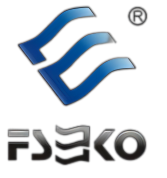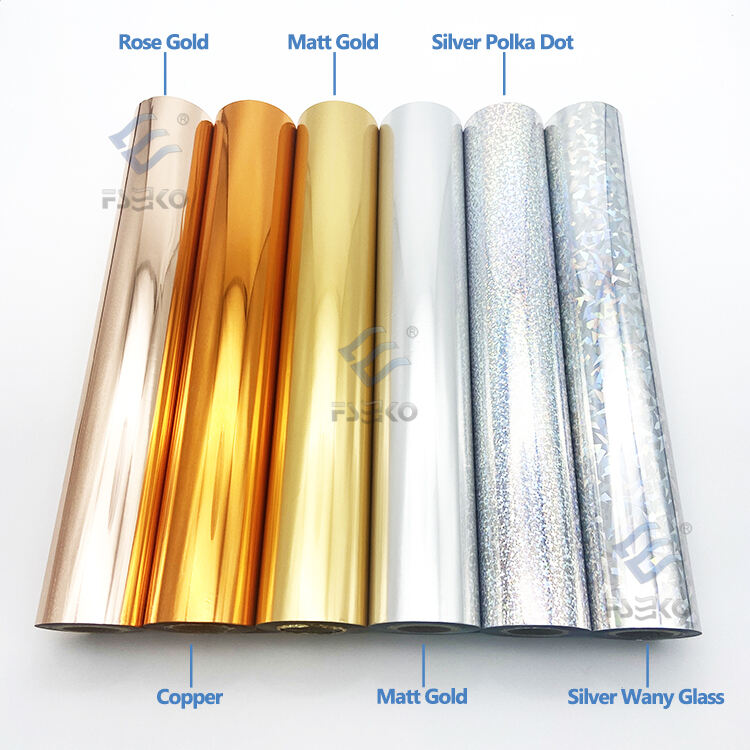Was ist digitale Heißprägfolie? Grundlegende Prinzipien erklärt
Die Wissenschaft hinter Druck-Wärme-Aktivierung
Die digitale Heißprägfolie überträgt Designs durch einen computergesteuerten Prozess, bei dem die Folie durch thermische Verbindung auf der Oberfläche des Substrats aktiviert wird. Merkmale: Spezialfolien, die auf bestimmte Temperaturen (150–200°F) reagieren und dadurch spezielle vernetzende Klebstoffe aktivieren, um metallische Oberflächen ohne Mindestdruck zu verbinden. Dabei werden grundlegende Prinzipien der Polymerchemie genutzt, wobei wärmesensitive Freisetzungsschichten unter Druck aufgelöst werden, ohne die holographischen Muster zu beschädigen. Die Druckeinstellungen (in der Regel 5–7 MPa) hängen von der Dichte des Substrats ab und ermöglichen eine mikroskopische Genauigkeit von 0,01 mm und weniger.
Digitale vs. traditionelle Foliendruckverfahren
Konventionelle Methoden erfordern gravurierte Metallstempel, um Designs einzuprägen – ein Verfahren, das Investitionen von über 5.000 US-Dollar in Werkzeuge und langwierige Einrichtungen erfordert. Digitale Varianten eliminieren diese Einschränkungen, indem sie die Folie direkt durch programmierbare CMYK-Kanäle mit einem Laser aktivieren. Wesentliche Unterschiede:
| Faktor | Traditionell | Digital |
|---|---|---|
| Einrichtungskosten | 3.000–15.000+ US-Dollar | 0 US-Dollar (Cloud-Vorlagen) |
| Lieferzeit | 3–6 Wochen | 3 Tage |
| Designflexibilität | Statische Stanzen | Unbegrenzte Überarbeitungen |
Bemerkenswert reduzieren digitale Einheiten physischen Abfall um 78 % pro EPA-Richtlinie, indem sie Probeabdrucke mit Stanzwerkzeugen eliminieren. Beide Techniken teilen grundlegende physikalische Prinzipien, unterscheiden sich jedoch in der Ausführung.
Vorteile der digitalen Heißprägetechnologie
Die digitale Heißprägetechnologie revolutioniert Fertigungsabläufe, indem sie Präzision, visuelle Wirkung und Umweltverträglichkeit kombiniert. Moderne Fortschritte ermöglichen es Marken, hochwertige Oberflächen zu erzielen und dabei entscheidende operative und Nachhaltigkeitsherausforderungen zu bewältigen.
67 % höhere Produktionsgeschwindigkeit (Branchenbericht 2024)
Neue Studien zeigen, dass digitales Heißprägen aufgrund des Wegfalls der physischen Herstellung einer Prägung 67 % schneller ist als herkömmliche Methoden. Gerade diese rapide Beschleunigung macht das Prototyping am gleichen Tag möglich und führt zu kurzen Lieferzeiten für Kleinserien im Verpackungsbereich. Eine Studie der Druckindustrie aus 2024 zeigte, dass Marken, die digitale Foliensysteme einsetzten, Aufträge über 500 Einheiten 53 % schneller auslieferten als jene, die ausschließlich auf traditionelle Werkzeuge vertrauten.
Lebendige Metall-Effekte zur Marktdifferenzierung
24 % gleichmäßigere Farben als die Alternative: Der Unterschied ist bei Luxusverpackungen und Sicherheitsdokumenten deutlich sichtbar. Die Technologie ermöglicht mikrofeine Pigmentverläufe ohne Schichtaufbau – nahtlos von gebürstetem Nickel bis Roségold. Diese Oberflächen wurden in einer Umfrage aus dem Jahr 2023 von über 80 % der Verbraucher mit Produktprämium in Verbindung gebracht und gelten somit als entscheidend für die Differenzierung am Point of Sale.
Umweltfreundliche Materialfortschritte
Unabhängige Tests bestätigen, dass digitale Folien der nächsten Generation Substratverschwendung reduzieren 38%durch gezielte Materialanwendung. Wasserbasierte Klebesysteme ersetzen mittlerweile lösemittelreiche Formulierungen und reduzieren die VOC-Emissionen in der Produktion um bis zu 90%. Ein Kreislaufwirtschaftsbericht aus 2025 stellt fest, dass 72 % der digitalen Folienmaterialien mit gängigen Recycling-Strömen kompatibel sind, im Vergleich zu 45 % bei traditionellen Folien.
Anwendung digitaler Heißprägfolien in moderner Verpackung
Sicherheitsmerkmale bei Luxuskosmetikboxen
Die Nutzung von digitaler Heißprägfolie ermöglicht es uns, manipulationssichere Merkmale umzusetzen, die insbesondere bei hochwertigen Kosmetikartikeln von besonderer Bedeutung sind, wie beispielsweise ein holographisches Overlay-Design mit Mikrotext-Mustern, die mit bloßem Auge nicht lesbar sind. Eine Untersuchung zur Bekämpfung von Fälschungen aus dem Jahr 2023 ergab, dass Verpackungen mit eingebetteten Foliensicherheitsmerkmalen die Anzahl gefälschter Produkte in Hochpreissegmenten um 58 % reduzieren. UV-reaktive Folien mit eindeutiger Seriennummerierung werden mittlerweile über Marken gelegt, wodurch diese sowohl mithilfe der Smartphone-Taschenlampe authentifiziert werden können, als auch gleichzeitig eine goldene/roségoldene Metalloptik beibehalten. Die digitale Abscheidung ist so präzise, dass keine Ausrichtprobleme entstehen, wie sie von der traditionellen Prägung bekannt sind, und aufwendige florale oder geometrische Muster stellen somit kein Sicherheitsrisiko mehr dar.
Interaktive QR-Code-Integrationsmethoden
Globale Getränkemarken nutzen leitfähige digitale Folien, um auf metallischen Untergründen scannbare QR-Codes zu erstellen – eine Herausforderung, die mit Standardfarben nicht realisierbar ist. Diese auf Folien basierende Lösung erreicht eine Erfolgsquote von 92 Prozent beim ersten Scan (2024 Osram Mobile Engagement Metrics) bei reflektierenden Oberflächen auf Aluminiumdosen oder folienumwickelten Kartons. „Die Codes werden strategisch in gefolienerten Logos oder Rahmen eingearbeitet und verbinden so Funktion und Gestaltung.“ Das Verfahren ermöglicht zudem Echtzeit-Updates der URLs, ohne dass die Stanzwerkzeuge ausgetauscht werden müssen. Somit können Sondereditionen direkt zu einem AR-Erlebnis oder Nachhaltigkeitsnachweisen führen.
Entwicklung digitaler Technologien im Foliendruck
Nanotechnologie-Beschichtungen für verbesserte Langlebigkeit
Post-millennium digitale Foliensysteme nutzen nanopartikelangereicherte Beschichtungen, um eine 2,3-mal bessere Kratzbeständigkeit als Standardfolien zu erreichen (2024 Folien-Dauerhaftigkeitsbericht). Diese Polymer-Schichten, 80 bis 120 nm dick, bilden eine molekulare Bindung mit dem Substrat und verhindern vorzeitigen Verschleiß sowie eine langfristige Langlebigkeit in Anwendungen mit hohem Reibungsgrad, wie beispielsweise bei Verschlüssen für Luxusverpackungen. Eine Lebenszyklusstudie aus 2023 zeigte zudem, dass Folien mit Nanobeschichtung bis zu 85 Prozent länger die gleiche Reflektivität unter UV-Bestrahlung behalten im Vergleich zu standardmäßigen Metallfolien. Neuere Entwicklungen ermöglichen zudem wasserbasierte Beschichtungen ohne Gefahrstoffe, die den Nachhaltigkeitskriterien der EU REACH-Richtlinie entsprechen und gleichzeitig eine gute Haftfestigkeit aufweisen.
Cloud-basierte Plattformen für Designzusammenarbeit
Der Wechsel zu browserbasierten Workflow-Tools hat die Genehmigungszyklen für individuelle Folienentwürfe um 40 Prozent reduziert (Packaging Digest 2023). Teams können nun metallische Oberflächen in Echtzeit simulieren mithilfe von:
| Traditioneller Prozess | Cloud-basierter Workflow |
|---|---|
| 7-10-Tage-Physischer Probendurchlauf | Sofortige 3D-Darstellung mit AR-Vorschau |
| Manuelle Versionskontrolle | Automatisch synchronisierte Designiterationen |
| Einschränkungen beim lokalen Serverspeicher | Unbegrenzter Cloud-Archivzugriff |
Cloud-Plattformen integrieren sich beispielsweise mit digitalen Folienpressen, um Druck-/Temperaturparameter basierend auf Substratdaten automatisch anzupassen und erreichen so eine Erstlaufgenauigkeit von 99,2 % bei Verpackungsversuchen mit mehreren Materialien. Dieser digitale Workflow ermöglicht es Marken, kurzfristige Updates zu Festtagsthemen innerhalb von 48 Stunden weltweit bei Lieferanten umzusetzen.
Auswahl von Digital Hot Stamping Folien: Strategische Überlegungen
Die strategische Einführung von Digital Hot Stamping erfordert eine Bewertung der Produktionsanforderungen im Hinblick auf Markenziele. Im Gegensatz zu traditionellen Methoden, die durch Mindestbestellmengen eingeschränkt sind, eignet sich diese Technologie besonders gut für agile Fertigungsumgebungen, in denen schnelle Iterationen und kleine Losgrößen für die Marktreaktivität entscheidend sind.
Kosten-Nutzen-Analyse für Kleinserienprojekte
Digital-Heißprägung eliminiert die teuren physischen Prägewerke und die damit verbundenen Einrichtungskosten, die bei analoger Technik erforderlich sind. Selbst kleine Auflagen und Testmärkte können somit kosteneffizient umgesetzt werden. Eine Studie der Druckindustrie aus 2024 ergab, dass die Stückkosten für Aufträge unter 500 Einheiten um 42 % niedriger sind als bei traditioneller Folienprägung. Die größten Kosteneinsparungen im Bereich Mikrofertigung resultieren aus reduziertem Materialabfall und schneller Auftragswechsel, die eine Fertigung am selben Tag ermöglichen. Solche Flexibilität entsteht, da Investitionskosten für Werkzeuge durch variable Kosten ersetzt werden, die sich an der tatsächlichen Produktionsmenge orientieren.
Markenidentität durch Textur-Effekte
Als ruhiger Markenbotschafter in hochwertiger Verpackung überzeugt die perfekte Texturintegration. Mit digitalen Folien, auf die Kabelhersteller Zugriff auf über 15 zertifizierte Spezialoberflächen haben – wie holographisch, gebürstetes Metall oder samtweich – können Markengeschichten durch das Gefühl des Taktilen lebendig werden. Kosmetikmarken setzen beispielsweise auf matt strukturierte Folien, um ihr visuelles "Clean Beauty"-Ethos widerzuspiegeln, während ein geprägter Metalleffekt ein gesteigertes Luxusgefühl vermittelt, ohne die Recyclingfähigkeit zu beeinträchtigen.
| Überlegung | Kleine Losgrößen (<1.000) | Große Losgrößen (>5.000) |
|---|---|---|
| Einrichtungskosten | $45–$220 | $600–$2,800 |
| Lieferzeit | Stunden | 5–10 Werktage |
| Farbvielfalt | Unbegrenzt | Durch Stanzwerkzeuge begrenzt |
| Mindestbestellung | 1 Einheit | 250+ Einheiten |
FAQ
Was ist digitale Heißprägfolie?
Digitales Heißprägefolientechnologie ist eine Methode, bei der Designs mithilfe eines computerkontrollierten Prozesses durch Hitze und Druck präzise und detailliert auf ein Substrat übertragen werden.
Wie unterscheidet sich das digitale Heißprägen von traditionellen Methoden?
Im Gegensatz zu traditionellen Methoden, die gravierter Metallstempel bedürfen, verwendet das digitale Prägen programmierbare Kanäle, um Folien zu aktivieren, und bietet so unbegrenzte Designflexibilität bei erheblich reduzierten Vorlaufkosten und Lieferzeiten.
Welche umweltfreundlichen Vorteile bietet die digitale Heißprägefolientechnologie?
Die digitale Heißprägefolientechnologie reduziert Substratabfall um 38 %, senkt VOC-Emissionen um bis zu 90 % und stellt sicher, dass 72 % der Materialien mit Recycling-Strömen kompatibel sind.
Welche Anwendungsbereiche gibt es für digitale Heißprägefolie?
Digitales Heißprägen kann für luxuriöse Verpackungen von Kosmetikprodukten, die Integration interaktiver QR-Codes und vieles mehr eingesetzt werden. Es bietet sowohl ästhetischen als auch verbesserten Sicherheitswert.
Warum sollte eine Marke digitale Heißprägefolie in Betracht ziehen?
Marken sollten dies in Betracht ziehen, da es durch schnelle Produktionsgeschwindigkeiten, lebendige Metallfinishs, umweltfreundliche Verbesserungen und Anpassungsfähigkeit an die Kleinserienfertigung überzeugt.
Inhaltsverzeichnis
- Was ist digitale Heißprägfolie? Grundlegende Prinzipien erklärt
- Vorteile der digitalen Heißprägetechnologie
- Anwendung digitaler Heißprägfolien in moderner Verpackung
- Entwicklung digitaler Technologien im Foliendruck
- Auswahl von Digital Hot Stamping Folien: Strategische Überlegungen
-
FAQ
- Was ist digitale Heißprägfolie?
- Wie unterscheidet sich das digitale Heißprägen von traditionellen Methoden?
- Welche umweltfreundlichen Vorteile bietet die digitale Heißprägefolientechnologie?
- Welche Anwendungsbereiche gibt es für digitale Heißprägefolie?
- Warum sollte eine Marke digitale Heißprägefolie in Betracht ziehen?


